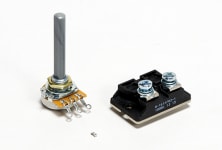Q: What are SMD resistors?
A: SMD stands for Surface Mount Device. An SMD is any electronic component that is made to use with Surface Mount Technology (SMT). SMT was developed to meet the ongoing demand for printed circuit board (PCB) manufacturers to use smaller components that are faster, more efficient, and cheaper. SMDs are smaller than through-hole resistors and instead of having wire leads that go through PCB, they have terminations that are soldered to pads on the surface of the board. This eliminates the need for holes in the board and allows both sides of the board to be used more fully.
Q: How are SMDs made?
A: SMDs are made by placing end connection electrode bases onto an alumina or ceramic substrate. The resistor is then fired to ensure the electrodes are held in place. Next, a film of resistive material is printed or deposited and the resistor is fired again. The resistor is then covered with successive layers of a protective coat that dry between applications. These layers prevent mechanical damage and ingress of moisture and other contaminants. Finally, a marking is placed on the resistor if the surface is large enough. The resistors are packaged in a form of blister roll for use on pick and place machines, or they can be supplied as loose components.
Q: What is the difference between SMD and SMT?
A: One of these terms is a device and the other is a process. A SMD, or surface mount device, is an electronic resistor you would find on a printed circuit board (PCB). SMT, or surface mount technology, is the method of placing components such as SMDs onto a PCB. Production speeds up using SMT as opposed to older through-hole technology, but the risk of defects also increases because of SMD miniaturization and denser packing of boards. An SMT is smaller than a through-hole PCB because it has either small leads or no leads at all.
Q: How do you read a SMD resistor code?
A: Because SMDs are tiny, they are marked with three- or four-digit codes called SMD Resistor Codes that indicate their resistance values. With a three-digit SMD code, the first two numbers indicate the significant numbers of resistance. The third number will either be a multiplier that must be multiplied by the first two significant numbers, or it will indicate how many zeros should be added to the first two numbers. The letter “R” is used for the decimal point. Resistances below 10 ohms (Ω) do not have a multiplier. Reading 4-digit codes is the same except there are three significant numbers, rather than two, with the last still indicating the multiplier or how many zeros to add to the first two numbers.
Q: What are the advantages of SMDs?
A: Advantages of SMDs include their smaller size, much higher component density, more connections per component, and a simpler and faster automated assembly. Additionally, components can be placed on both sides of a printed circuit board (PCB), fewer holes need to be drilled into a PCB, they have better mechanical performance under shock and vibration conditions, and many SMT parts are cheaper than through-hole parts.
Q: What are the disadvantages of SMDs?
A: SMD solder components can get damaged by potted compounds going through thermal cycling, SMT may be unsuitable as the sole attachment method for components that may encounter frequent mechanical stress, and many types of SMT component packages cannot be installed in sockets, which allow easy installation or exchange of components. Additionally, manual prototype assembly and component repair is more complicated and requires skilled workers and more expensive tools. SMDs have less surface area for marking, requiring part ID codes or component values to be smaller and more cryptic. Lastly, SMDs cannot be directly used with plug-in breadboards. They require either a custom printed circuit board for every prototype or mounting the SMD on a pin-leaded carrier.
 e
e
 e
e
 e
e
